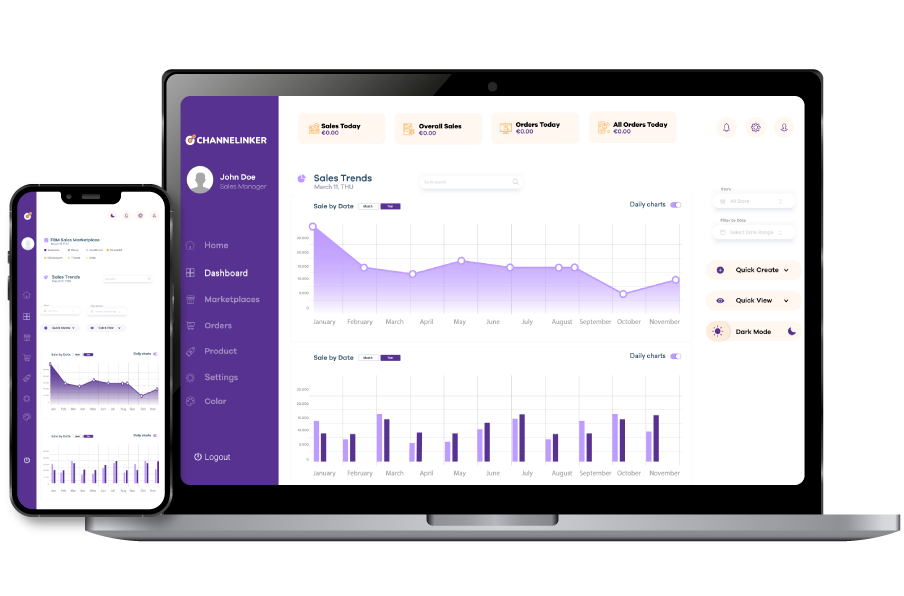Product Information Management (Pim)
Empower Your E-commerce with Precision Product Management

Product Information Management (PIM)
Selling on multiple marketplaces has become a standard for e-commerce businesses. However, managing products across various marketplaces might be challenging. At this point Product Information Management (PIM) is critical. PIM system is software that businesses can easily manage and synchronize product data across multiple channels.
Product Information Management (PIM) covers the processes of collecting, managing, and distributing all information about the company’s products through various channels. The PIM system is used to manage these processes through a single database. This system reduces errors and allows the use of accurate information about the products in marketplaces.
Key Benefits of Our PIM Solution
Centralized Data Control
Manage all product information from a single, powerful hub, ensuring consistency across your entire catalog. This centralized approach eliminates data discrepancies and streamlines your workflow, saving time and reducing errors.
Multi-Channel Synchronization
Instantly update product data across all connected e-commerce platforms and marketplaces. This seamless integration ensures that your product information is always current and uniform, regardless of where your customers are shopping.
Enhanced Product Presentation
Easily enrich and customize product details for improved customer engagement. Create compelling product descriptions, add high-quality images, and tailor content for different markets or customer segments, all from one intuitive interface.

Check out all our other features!
Each feature is designed to enhance your e-commerce operations, from seamless integrations to advanced analytics.
Product Information Management (PIM)
Empower Your E-commerce with Precise Product Management
Inventory Management
Precise Control, Real-Time Insights, Effortless Growth: Unlock the Power of Smart Inventory Management
Order Management
Organize Orders, Increase Success: Your All-in-One Command Center

Fullfillment Management
Gelişmiş Gönderim ile E-ticaretinizin Tüm Potansiyelini Ortaya Çıkarın
Catalog Listing
Boost Your E-commerce Presence with Strategic Listing Management
Catalog Mapping
Unlock the Full Potential of Your Product Catalog
Returns Management
Live, interactive insights for data-driven business decisions.
EDI Integration
Simplified EDI processing with enhanced order flow capabilities.
How Does PIM Software Work?
There are four key factors in the PIM working system. These are centralized, managed, optimized, and distributed. PIM centralizes processes by ensuring that all product information and digital assets are managed through a single system. On the other hand, products help the business’s workflows and need to be managed appropriately. In this way, product information can be easily optimized during sales.
Distributing products through a single channel not only reduces the time it takes for your products to reach the market but also reduces the margin of error in the process.
What Are the Benefits of Using PIM Software?
PIM software offers several benefits, especially for businesses that sell on multiple marketplaces. These benefits are listed below:
One of the first and most important benefits is that it provides data consistency and accuracy. Up-to-date information about all products can be accessed from a single place. PIM reduces the need to manually manage product listings in multiple locations, allowing products to be released quickly across different channels.
PIM is not only a tool that collects information about all products in a single system, but also a tool that allows all processes to be managed on a single platform.It provides cost-efficiency to businesses as it requires fewer errors and less manual intervention. PIM systems have a scalable structure. They can be used for more than one marketplace, adapting to the growing business volume of the business.
How To Implement A PIM System?
Step 1: Plan and Gathering:
Before starting the installation, the existing product information should be collected in a single place.
Step 2: Deletion of Old Information:
Old and incorrect information should be deleted later.
Step 3: Review of Data Features:
A comprehensive knowledge of the capacity and features of the selected PIM system should be obtained.
Step 4: Data Control
Product data should be checked again to ensure that it is correct and complete and that it is a sole source.
Step 5: Test & Transition
After ensuring that everything works smoothly, all data is transferred to the PIM system.

Questions done? Let's meet now!
Once all questions are answered, it’s time to connect with us. Let’s schedule a meeting to discuss how we can assist you further with your needs.
Explore our solutions and discover how we can help streamline your operations. Contact us today to take your business to the next level!
Frequently Asked Questions About Product Information Management (PIM)
PIM positively impacts the customer experience by ensuring product data is accurate, consistent, and accessible across all sales channels, reducing confusion and increasing satisfaction.
A PIM system needs to have features such as product classification, centralized data management, media connectivity, and data validation.
The PIM system is widely used in a variety of industries, including retail, manufacturing, healthcare, and consumer goods.
While PIM focuses on managing data, descriptions, or media related to products, MDM focuses on broader processes such as customer and supplier data.

